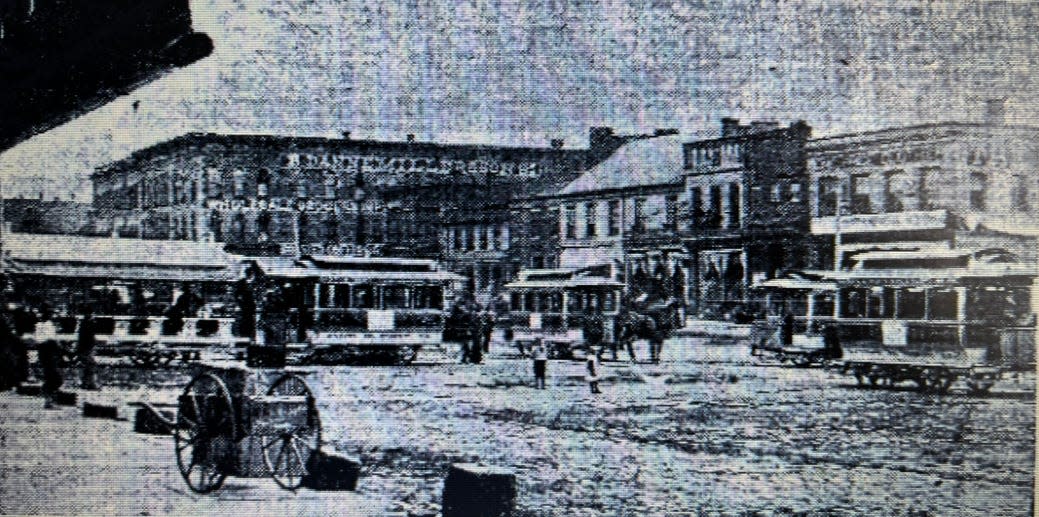The Monday After: Peering into the pages of Canton's past

A window to the past was opened 100 years ago, and readers of The Sunday Repository looked through it April 15, 1923.
"Fifty-Year-Old City Directory Recalls Canton Residents And Scenes Of Half A Century Ago," a headline atop the article said. "Lester Deweese Draws A Vivid Picture Of City In 1870."
Deweese, the writer of the article, had the chance to go through the decades-old directory, which offered the names of residents and other information about communities in the Akron-Canton area, including those two cities and also Alliance, Cuyahoga Falls, Middelbury, Kent, Ravenna, Massillon, Salem and Wooster.
"Eighty of its 335 pages are devoted to Canton," wrote Deweese in 1923. "Much material bearing on the Canton of 50 years ago is said to be found within those 80 pages, the most interesting being based on the progress made by the town in the past half century of its existence."
Deweese discovered Canton wasn't the same community as so many decades before.
"Seven pages are devoted to the history of the town and a statement as to 'manufacturing Interests,'" the directory said. "In this, the population is given as 11,120 in 1869, having been 4,442 in 1860, 2,740 in 1850, 2136 in 1840. The 1869 population of 11,120 is a statement that 'runs true to form' in the cases of booming towns."
By 1923, the city had grown through its industry, in those years, and even more so in decades to follow, according to another directory published near the time the article was published.
"There are approximately 1,900 persons and firms listed, an average of one name for every 4 1/2 persons in the town," the article noted. "In the current (1922) Directory of Canton, the 33rd issue published for this city by The Burch Directory Co. of Akron, the statement is made that there are by actual count 42,927 individual names and this number multiplied by 2 to cover the names of children under 15 years of age, and married women, would indicate a present population of 85,854."
Street names and garden space
In the 1870 directory, 28 streets – with no avenues, courts, places or roads – were mentioned in the addresses for residences. No homes were numbered.
"Of those 28, only eight of the designations have survived the 50 years," said the 1923 article.
Streets were narrower in 1870, and lots were larger.
"Extra space in the lots was taken up with gardens in the summer time, and the thrifty householder raised a goodly part of the vegetables used on the family table," said the article. "With the exception of a few in the very center of town, none of the lots had been sub-divided, whereas they are now halved and quartered, and some of the quarters are said to be worth more than Bezaleel Wells figured his whole town to be worth when the surveyor finished his job."
Jobs included merchant, manufacturer, druggist, insurance agent, farmer, clothes cleaner, doctor, lawyer, jeweler, dentist and banker. Also listed were speculator, cooper, boat maker, horse doctor, lightning rod furnisher, omnibus proprietor and eating house operator.
"It was apparently a thing to be a 'gentleman,' so those ten were thus listed," the article noted. "Several of the names are of men who later figured in the manufacturing activities of the city."
There were four livery stables in the town in 1870. Some 33 grocers were listed. Eleven saloons were doing business in Canton.
Fourteen physicians were tending to the health of the people of the community, while there were 18 attorneys handling their legal matters.
Businesses listed were numerous and recognizable to historians, but perhaps not so much to residents of today.
"Though a number have come through the 50 years with little or no change in ownership or business further than the changes which are made in the interest of good business, only 'The First National Bank' remains in the 1922 directory the same as in the 1870 issue."
Officials served residents
Daniel Saylor was mayor of Canton in 1870, the directory shows. Councilman included Daniel Worley, Louis Schaefer, Jacob Hawk, Frederick Lindaman, James Saxton, Peter Myers and William Wyant. William A. Lynch was said to be Stark County prosecuting attorney.
A person the directory didn't yet credit as being a leader in the community was William McKinley, who, with information for the 1870 directory presumably compiled before he was elected as prosecuting attorney for Stark County in 1869, was listed simply as a lawyer with an office in the Eagle Block.
His brother, A.O. McKinley, was listed as a "student" who lived on Tuscarawas St. W.
"The directory fails to give the home address of the future President, nor is mention made of Wm. McKinley Sr., at whose home the two young men lived," said the directory. "A.O., better known as Abner, is the only ‘student’ listed in the directory, probably because he was a law student. The law firm of W. & A. McKinley having opened in the block owned by their father, Wm. McKinley, Sr., within a few years of the publication of the directory."
Reach Gary at gary.brown.rep@gmail.com. On Twitter: @gbrownREP.
This article originally appeared on The Repository: The Monday After: Peering into the pages of Canton's past

